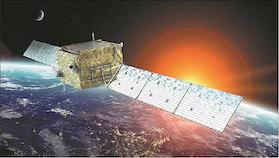|
|
DAMPE

The Dark Matter Particle Explorer (DAMPE)
satellite, also known as “Wukong” (a reference to the Monkey King
hero in the Chinese story “Journey to the West”), is a Chinese
Academy of Science
mission to measure highly energic electrons and photons with high resolution
in order to identify possible dark matter signatures.
The satellite was launched into a polar, sun-synchronous orbit with an altitude of
500 km on December 17, 2015. The Long March-2D rocket carrying DAMPE to orbit was
launched from the Jiuquan Satellite Launch Center in China. At the start of
operations, the mission was planned to have a three year service lifetime, but that
was extended for a further two years in December 2018.
Mission Characteristics
 Lifetime : December 17, 2015 – present
Lifetime : December 17, 2015 – present
 Energy Range : 5 GeV – 100 TeV
Energy Range : 5 GeV – 100 TeV
 Special Features : DAMPE observes the direction, charge, and energy
of electrons and
high-energy photons which would be generated when Weakly Interacting Massive Particles
(WIMPs, one of the candidate dark matter particles) annihilate: previous observations
by other instruments have suggested this is a likely candidate for dark matter.
Special Features : DAMPE observes the direction, charge, and energy
of electrons and
high-energy photons which would be generated when Weakly Interacting Massive Particles
(WIMPs, one of the candidate dark matter particles) annihilate: previous observations
by other instruments have suggested this is a likely candidate for dark matter.
 Payload :
Payload :
DAMPE is a single instrument mission. The detector contains multiple elements,
stacked vertically atop each other along the Z (observational direction) axis of
the spacecraft:
- The Plastic Scintillator Detector (PSD), which consists of a double layer of
1 x 2.8 x 82 cm staggered strips laid out in alternativing layers of X and Y
orientation. with a 82 x 82 cm total area. The PSD detects the charge of cosmic rays and
also serves as an anti-coincidence detector for energic photons. It has a position
resolution of 6 mm and charge resolution of 0.25 for Z = 1 - 20. It also serves as a
backup to the STK element.
- The Silicon-Tungsten Tracker (STK), which consists of multiple layers of
silicon micro-strip detectors with interleaving tungsten converter plates.
STK tracks the direction of gamma-rays by their conversion to charged particles
in the tungsten plates, then tracking the particles through the instrument. STK
has 6 tracking planes, each with two layers in X and Y planes, orthogonal to the
intrument pointing. Cumulatively, this makes a sensor with 0.2°
angular resolution at 10 GeV and the total silicon area is roughly 7 m2.
- Bismuth-Germanium Oxide (BGO) calorimeter, which contains 308 bismuth germanate
crystal bars, 2.5 x 2.5 x 60 cm, stacked in 14 layers in alternating X and Y direction
orientations. A 0.5 mm gap around each crystal is filled with a silicone elastomer to
hold each crystal in place and to prevent damage from launch vibrations. Incident
particles interact with the crystals, generating a pulse of optical light which is
detected by photomultipliers and each layer edge. The calorimeter is sensitive to
energies between 5 GeV to 10 TeV.
- Neutral Detector (NUD), which consists of four large boron-doped plastic scintillation
detectors, 30 x 30 x 1 cm in size. Each detector is equipped with a photomultiplier tube
to measure light flashes causes by incident neutral particles exciting the boron and
generating alpha particles and gamma-rays. The gamma-rays are converted
to light pulses recorded by the instrument.
[DAMPE at University of Geneva (English)]
[All Missions]
[by Time]
[by Energy]
Page authors: Lorella Angelini Jesse Allen
HEASARC Home |
Observatories |
Archive |
Calibration |
Software |
Tools |
Students/Teachers/Public
Last modified: Thursday, 24-Sep-2020 17:21:49 EDT
|


